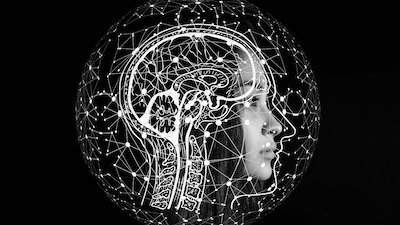
What Makes the Human Brain Function?
Does a designer DNA duplicate or a lucky genetic goof make the human brain do what it does do so well?
News Source
- ScienceDaily: “Extra Gene Drove Instant Leap in Human Brain Evolution”
Two studies just published in Cell reveal the way a uniquely human genetic nuance probably helps the human brain develop the efficient interconnections needed to support its complex functions. The studies propose an evolutionary history of that gene, which is a modified duplicate of a neighboring gene. They believe the gene is a randomly mutated, truncated duplicate that transformed our ape-like ancestor’s brain into human form.
Franck Polleux and Evan Eichler led two research teams examining a human gene called SRGAP2. They say the gene has “been duplicated twice during the course of human evolution, first about 3.5 million years ago and then again about 2.5 million years ago.” Happily for the evolutionary model, the latter just happens to be about time evolutionists believe human ancestors diverged from Australopithecine ancestors.
The duplicate gene actually has some differences and is also incomplete. That incomplete copy inhibits expression of it counterpart. The researchers believe the incomplete version evolved from the full version and was helpful in hominid brain evolution. In mice, SRGAP2 accelerates the migration of neurons during brain development. Inhibition of the gene causes mouse neurons to grow knobby extensions and interconnect more freely. Polleux and Eichler believe these spiky knobs help neurons to interconnect more efficiently.
The researchers suggest this and similar “human-specific gene duplicates” helped ape-like ancestors leap to more efficient brain function and scamper up the evolutionary intellectual tree, leaving their cousins in the dust.
”We may have been looking at the wrong types of mutations to explain human and great ape differences,” Eichler explains. “These episodic and large duplication events could have allowed for radical—potentially earth-shattering—changes in brain development and brain function.”
Gene duplication can occur, but the presence of genes in duplicate or variant form does not prove they resulted from random mutation.
Gene duplication can occur, but the presence of genes in duplicate or variant form does not prove they resulted from random mutation. The similarity of molecular structure in such a partial duplicate would make it ideally suited for its regulatory role by making it recognizable by the loci affected by the primary form of the gene. Nothing about the existence of such an important duplicate demonstrates its evolutionary or random origin in deep time.
Furthermore, the time when the duplications are supposed to have occurred derive from molecular clock estimates. Molecular clock estimates are based on the unverifiable constancy of mutation rates and some statistical fallacies by which molecular clocks are calibrated. And the supposed fossil proof of Homo evolution from ape-like ancestors is dated in accord with the same assumptions used to calibrate molecular clocks. Since these hypothetical evolutionary events are dated according to the same assumptions and are mutually dependent, their agreement is an expected result of circular reasoning. The agreement of the dates therefore gives only the illusion of reliability and confirmation.
Many people don’t realize how much bias is built into these numbers. Molecular geneticist and creationist Dr. Georgia Purdom says, “People need to understand that many assumptions by the scientists, like human evolution from an ape-like ancestor, have a direct effect on how the scientists compare the genomes. They compare them in a way that will achieve the conclusion they have already determined is true—that humans and apes share common ancestry. It's truly a case of circular reasoning!”
If the animal model here is accurately demonstrating the function of the partial gene duplicate, this discovery could be genuinely useful in understanding neurological abnormalities characterized by “bad connections” between neurons. Such conditions include autism, epilepsy and schizophrenia. But the role of this gene in human brain development has nothing to do with presumptive evolutionary history. The neuronal connections and the genetic functions exist in the present and do not demonstrate anything about their own history through deep time. Our only reliable information about human origins is the eyewitness account in Genesis telling us He created Adam and Eve in his own image distinct from the animals by His own perfect design.
Further Reading
- News to Note, March 17, 2012
- Greater Than 98% Chimp/Human DNA Similarity? Not Any More.
- If Human and Chimp DNA Are So Similar, Why Are There So Many Physical and Mental Differences Between Them?
- Chimp Genome Sequence Very Different from Man
- Did Humans Really Evolve from Apelike Creatures?
- New Science Can’t Save an Old Farce
- News to Note, June 18, 2011
- News to Note, December 31, 2011: Year in Review
For More Information: Get Answers
Remember, if you see a news story that might merit some attention, let us know about it! (Note: if the story originates from the Associated Press, FOX News, MSNBC, the New York Times, or another major national media outlet, we will most likely have already heard about it.) And thanks to all of our readers who have submitted great news tips to us. If you didn’t catch all the latest News to Know, why not take a look to see what you’ve missed?
(Please note that links will take you directly to the source. Answers in Genesis is not responsible for content on the websites to which we refer. For more information, please see our Privacy Policy.)
Recommended Resources

Answers in Genesis is an apologetics ministry, dedicated to helping Christians defend their faith and proclaim the good news of Jesus Christ.
- Customer Service 800.778.3390
- © 2024 Answers in Genesis






